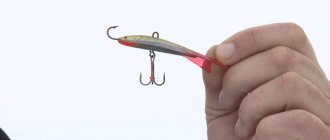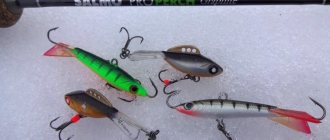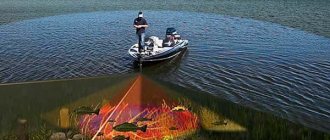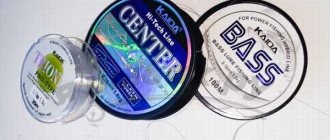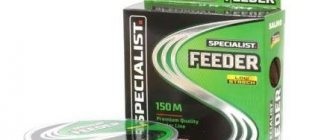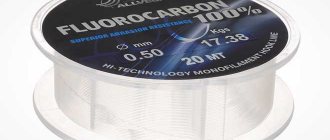In this article we will talk about the pros and cons of different types of fishing lines for winter fishing and name the three best options for each type. With the onset of cold weather, water bodies become covered with ice and many anglers switch to winter fishing. It is somewhat different from fishing in the warm season. Equipment plays a special role. The requirements for gear are higher, and the outcome of the entire fishing trip can depend on the choice of good winter fishing line. Winter fishing line is characterized by increased strength and can easily withstand temperature changes, unlike regular fishing line. In this article we have selected the 9 best fishing lines for winter fishing.
Types of forests
It happens that the manufacturer himself gives hints on the packaging. For example, the mark “Winter” or “Ice” means that the line is suitable for winter and ice fishing. In cold water, fish are more careful and picky, so anglers use fishing lines with the thinnest diameter. Most often they are presented with a diameter of up to 0.25 mm and in small unwinds - 25 m, 30 m and 50 m, which are not suitable for feeder, carp or spinning fishing. A lot of fishing line is not required, because the working area is the distance from the hole to the bottom of the reservoir. Braided fishing lines with this mark are distinguished by a special chemical coating, thanks to which they do not absorb water. In severe frosts, it saves you from severe freezing. These are some of the main differences between winter braided cords.
There are three main types of fishing lines:
- Monofilament
- Fluorocarbon
- Wicker
Monofilament line
This line stretches well and often has a dark color (black, green, red) so that it is clearly visible in the snow.
Advantages:
- has good stretch, which helps when landing fish
- has high elasticity, which avoids tangling
- has good knot strength
- of all types of fishing lines - the most affordable
Flaws:
- short-lived, tends to dry out due to natural factors
- due to stretching, low sensitivity
Based on the experience of our experts and feedback from experienced anglers, we have selected the 3 best monofilament fishing lines for winter fishing:
Gamakatsu Super G-Line
-5%
Line Gamakatsu Super G-Line 0.12mm 50m 395 RUR
Line Gamakatsu Super G-Line 0.12mm 50m
Add to cart
Premium Japanese fishing line, 50 m reel serves as the main winter fishing line. Has a protective coating that protects against exposure to ultraviolet rays. It also has a special Extreme Abrasion coating that prevents exposure to the environment and temperature, as well as abrasion upon contact with snags and various underwater obstacles. Super G-Line has no memory, is very strong at the knots, is universal and is equally suitable for both winter fishing and other types of fishing. Expensive, but reliable and flexible. It won’t let you down when biting a large fish!
Sunline Siglon V ice fishing clear
-20%
Sunline Siglon V ice fishing line clear 50m 0.4/0.104mm 243 ₽
— 48 ₽
195 ₽
Line Sunline Siglon V ice fishing clear 50m 0.4/0.104mm
Add to cart
Specialized Japanese fishing line for winter fishing. Triple coating with resin minimizes the moisture-absorbing properties of nylon, preventing freezing of the fishing line. Thus, Siglon V Ice Fishing retains all its properties at the lowest temperatures. And thanks to its sufficient rigidity, it practically does not get tangled even in strong winds. The presence of thin diameters and an affordable price make this fishing line very popular among winter fishing enthusiasts. Siglon V Ice Fishing is an excellent choice for both jig and balance fishing.
Sufix Ice magic
-5%
Sufix Ice magic winter fishing line 50m 0.155mm transparent 320 ₽
Fishing line Sufix Ice magic winter 50m 0.155mm transparent
Add to cart
Line with a wide temperature range, great for fishing in warm and cold water. It has high strength, has virtually no residual memory and combines softness and elasticity, with a high breaking load at the nodes. Sinking, which allows the use of lighter baits. The best price-quality ratio.
Monoline or braided line for winter fishing
When fishing at depth, it is preferable to use monofilament, which allows you to perfectly catch and control the bottom.
When fishing with bottom spinners (which are heavier than spinners and beach spinners designed for fishing in the water column), we recommend using monofilament with a diameter of 0.2-0.22 mm. This diameter is the most optimal, because, first of all, it ensures reliability (because when bottom lures are used, big fish are often caught), and at the same time, a neat play of the lure is obtained. It probably goes without saying that you can also use fishing line with a diameter of 0.25-0.3 mm, but you won’t get such accuracy with it. The narrowest fishing line that is advisable to use for bottom trolling is 0.18 mm.
But at greater depths (15-20 meters) we need to switch to braided line, because the monofilament will stretch like rubber, and we will not be able to achieve normal play.

The disadvantage of braids is that they do not spring. When catching fish with braided line, much more often you have to use fishing with a whip: we hook the fish, and during the first, main jerks, we hold it on a long whip, always maintaining tension. Throw it over the block. However, here a complication arises: we will have to land the fish with our hands or with a reel, but since our reel is small, it will not be very comfortable to lift the fish onto it from a huge depth. Based on this, we put the fishing rod aside and fish it with our hands. But because the braid does not spring, when fishing by hand there will be a large number of line slips, which is also problematic.
What can you recommend? When fishing in pairs, when one hooks a good fish that is a pity to lose, he should be directed, holding the fish on the whip, to begin to move away from the hole. It is better for the second to throw his fishing rod, run up to the hole, pick up the fishing line and hold it in the center above the hole, while the first one moves away from the hole with a whip at a distance equal to the depth of the reservoir in a given place (for example, 15 meters). So, it is possible to avoid going on a braided fishing line.
If you are fishing alone, it will be more difficult. Let us recall that, according to our point of view, monofilament for bottom trolling is more effective than braided fishing line, which has one more drawback: it freezes in winter, and the use of all kinds of impregnations (silicone grease, petroleum jelly, etc.) does not help. Based on this, when fishing with braided fishing line in the cold, certain troubles appear.
Ice fishing line: Fishing with Normund #29
Choosing fishing line for winter fishing
Fluorocarbon line
The main distinguishing feature is “invisibility” in water. Fluorocarbon line has virtually zero refraction. Due to the properties of the material, it is resistant to abrasion.
Advantages:
- not visible in water
- abrasion resistant
- due to its rigidity, it can be used in thick diameters as a leash when fishing for pike
Flaws:
- higher price compared to monofilament line
- has a memory, can come off rings from a reel
- when comparing the same diameters with monofilament fishing line, it will always hold the breaking load less
Top 3 fluorocarbon lines:
DAM Tectan Superior FC 25m
Line DAM Tectan Superior FC 25m 0.12mm 1.3kg 2.9lb 272 RUR
Line DAM Tectan Superior FC 25m 0.12mm 1.3kg 2.9lb
Add to cart
DAM Tectan fluorocarbon line has almost the same refractive index as water, so it is virtually invisible to fish. The line has a minimum stretch coefficient and high knot strength. Immune to ultraviolet rays, i.e. practically does not age and does not lose its qualities. Cheaper than its analogues. Made of fast-sinking material, which allows you to use the lightest jigs.
Line Owner Tournament FC 50m
Line Owner Tournament FC 50m 0.140mm 370 ₽
Line Owner Tournament FC 50m 0.140mm
Add to cart
High quality fluorocarbon fishing line. It sinks very well because it has a high specific gravity. Good resistance to temperature changes. This fluorocarbon is also produced in Japan. Owner has been on the market for over 50 years and is famous for its quality products.
Sunline Siglon FC HG 50m
Line Sunline Siglon FC HG 50m 1.75/0.245mm 491 ₽
Line Sunline Siglon FC HG 50m 1.75/0.245mm
Add to cart
Sunline Siglon FC is a high-quality fishing line, available in 50 and 30 meter reels. Small unwinding lengths were chosen to reduce the price so that the buyer does not overpay for extra meters, which may not be in demand for a long time. Good abrasion resistance, often used for leashes when fishing for pike. A well-known Japanese company, preferred by many athletes. Due to these factors, this fishing line is very popular, even at a fairly high cost.
Braided leash
Each fisherman has his own secrets and best practices. Here I am, no exception. As they say, the main gear that I fish with is a spinning rod, a float rod, an elastic rod (a donka with a rubber shock absorber) or a regular donka. And even among these gears, spinning takes up almost 80-90% of the time when fishing. And if you remember, when I said that it is not at all necessary to have an expensive spinning rod and reel, expensive baits and other components in order to stay with the catch. And taking into account the fact that I mainly fish on small rivers, even the cheapest spinning rod is capable of good casting. Of course, there are some incidents with the coil, but the latest purchase for 500 rubles so far works without any complaints. Well, continuing the conversation, I want to say that if you can “turn a blind eye” to some elements of the equipment, when fishing with a spinning rod, you need to pay close attention to the fishing line (braid).
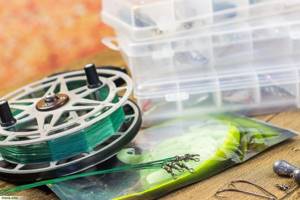
I think the line should be good. This is a very broad concept, but in general terms, it includes such parameters as: strength, elasticity, resistance to tearing, uniformity of diameter along the entire length, the ability to maintain strength at knots, and, of course, lack of memory. It is clear that high-quality fishing line cannot have a low price tag, but depending on your capabilities and the task at hand, you can always find a worthy specimen in the group.
About 5 years ago I slowly switched to fishing with braided line. There are a lot of reasons for this, I’ll name just a few: high strength with a smaller diameter (compared to fishing line), does not stretch, i.e. it’s easier to feel the bite from a distance, in the current, in the wind, when jigging you literally feel the bottom. Braid has a lot of advantages, although it is not without some nuances of use, in particular subtleties of care so that the thread does not deteriorate (read about comparing fishing line with braid here, it may help). So, a good braid, as a rule, has a very impressive price tag. And I remember one season, I think it was a year or two ago, when over the summer I tore off 30-40 meters of good braiding. When a snag occurs, the fisherman initially makes every effort to free the tackle, but often the tackle breaks. And it’s okay if the break occurs literally at the bait, but meters of braid can remain in the water. I feel sorry for the good cord. This is precisely the reason why I resorted to some tricks. So, when I fish in difficult places, I tie the bait itself not to braid, but to a short leash made of fishing line (most often, 0.3 mm in diameter). The length of such a leash is only about 50-60 centimeters, and I do not attach it directly to the braided line (in this case, the braided line will simply cut the line under load), using a swivel. If desired, you can also attach a metal leash to a fishing line leash if you are fishing for large pike. And even if the tackle gets stuck somewhere deeply, and there is no way to unhook it, it doesn’t matter - when under load, the fishing line always breaks first, keeping the precious braid intact.
By the way, such a short piece of fishing line as a leader material does not affect the sensitivity of the tackle at all, but allows you to avoid loss of braid when hooked. I hope you'll take note.
Good luck to you and all the best.
I recommend to read:
Devonian
Akara fishing lines review
Spring, last ice, emotions
Share with your friends!
Braided line (cord)
It is produced with the Ice/Winter mark and has a special impregnation and coating that prevents the accumulation of water (does not absorb it), which means it freezes minimally. Braided cord has increased strength, so it allows you to use the thinnest diameters. It has various colors, the winter series are mostly monochromatic. It is often used when catching predators at great depths. For example, fishing for pike perch on the Volga.
Advantages:
- due to a special chemical coating remains flexible at the lowest temperatures
- 2-3 times stronger than regular fishing line
- practically inextensible, transmits the most careful bites
Flaws:
- high price
- visible in water
- soft structure, easy to tangle
- It is better not to use without gloves, as it can injure your hands
Three best braided lines:
Power Pro Ice-Tec 45m
Cord Power Pro Ice-Tec 45m 0.13mm 8kg blue RUB 1,020
Cord Power Pro Ice-Tec 45m 0.13mm 8kg blue
Add to cart
Excellent for extreme ice fishing conditions. One of the best winter braided lines because it easily withstands the abrasive effects of ice. It practically does not absorb water, preventing the formation of an ice crust, which reduces strength and adds discomfort when fishing. The main advantages also include: hypersensitivity, increased knot strength. The downside is the high price.
Sufix Ice braid
-5%
Cord Sufix Ice braid 50m 0.06mm 710 ₽
Cord Sufix Ice braid 50m 0.06mm
Add to cart
Sufix Ice Braid has virtually zero stretch and excellent sensitivity. Very popular when catching predators. Modern “y6 braiding” technology gives the braid good frost resistance, while maintaining its characteristics. Long service life, with proper use can last two seasons of fishing.

